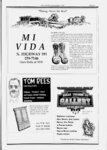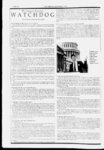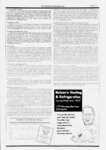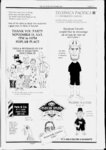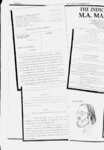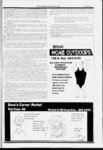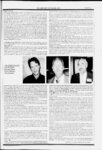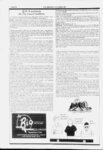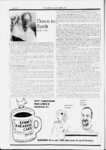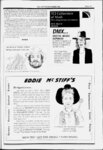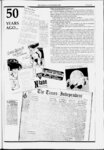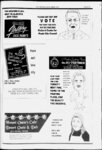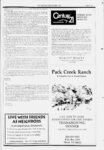| OCR Text |
Show THE ZEPHYRNOVEMBER 1995 PAGE 20 As an avid aficionado of history journey would play an even greater part in my mind. and genealogy, my interest centers on the early days of Utah's pioneer settlement. Since those Glen Canyon days. I've learned much more concerning that difficult trek. The Redds were a part of that drama. So let's follow John Hardison Redd, Charlie's great grandfather, an old sea captain and mariner who had settled in in 1836 at Sneads Ferry, Virginia and then North Carolina. Lemuel, his son, was born North Carolina in 1836. In 1843, a bunch of Mormon missionaries, including the notorious John D. Lee, did missionary work for the new Mormon religion. The Redds were converted and moved west in 1851 settling in Spanish Fork. In January 1856, young Lemuel, now 19 "mission" to years of age, married Keziah Jane Butler. In June they were called on a Las Vegas, Nevada. Shortly they returned to Spanish Fork where they had their first son, which they also named Lemuel. But not all went smoothly. For instance, in 1857 General Albert Sidney Johnson brought the might of the United States Army to put down the "Mormon rebellion." Then in the fall of 1857, some 120 Missouri emigrants, enroute to California, were killed at nearby Mountain Meadows by John D. Lee and other Mormon settlers and their Paiutc allies. This upset things for a while, but soon Mormon families again continued their colonization efforts. Lemuel and Keziah Redd were then "called" to help settle New Harmony in the spring of 1862. In November 1866, Lemuel took another wife, Louisa. Both wives bore large families. In 1870, Lemuel bought the John D. Lee farm at the head of Ash Creek. Lee had settled at nearby Fort Harmony in 1852, but had to abandon that place when two of his kids were killed when their house fell in during a flood. Then they made the move to New Harmony. George Spencer, my great-gregranddad, probably taught the Redd kids at New in 1867. He reportedly also had once taught to he there teach when went Harmony D. Lee's private family school. at John Spencer took on three wives and had 22 children. He died in 1872, at the young age of 42, as he was searching for more places for the Saints to colonize. His death spared him the travails of the approaching San Juan Mission trip) and the need to dodge federal deputies. New Harmony and other southern Utah towns entered the United Order in 1874 and the Redds, the Spencers, and other families became involved in that enterprise. faith-inspiri- ng From San Juan County... Around the Bend (Again) By Ken Sleight OUR CANYON LEGACY- -. THE REDDS AND THE SPENCERS This month, I review a book and add some rambling comments. Ed Abbey asked me a few years ago what I wanted to do when I grew up; I told him I'd like to be a literary critic or reviewer. He gave me that querulous look of his. When Hardy Redd, my neighbor friend across the mountain, told me that the Mormon historian, Leonard J. Arrington, was to write a biography of his father, the legendary Charlie Redd, I was quite thrilled. Recently the book was published under the appropriate name, Charlie Redd, which was well worth waiting for. As I read it, my thoughts continually turned toward my own experiences and that of my ancestors who also settled this region. So I'll interject an account of these with that of the Redd family - a kind of a personal review of history. When 1 was on a trip south with a bunch of college kids from the University of Utah back in 1951, roaming the southern part of the state, was fatefully led to the canyon country of my ancestors and relatives. That motley travel group was made up of a mixture of talent. Neldon Christensen of Monticcllo himself, provided local interest and history. He told me of the influential Redd family as we toured the graveled and dirt roads (few paved roads then). Redd, he said, was one of the largest stockmen in Utah. And Blaine Buscnbark, the nephew of old riverman Bert Lopcr, filled me in on the Colorado River. And photographer Jim Dean who had been on a Bert LoperMoki Mac Ellingson river trip through Glen And Bob Canyon extolled the virtues of Glen Canyon and the to become a and maker defender of national and the Waite, college history professor parks (some that Congressman Jim Hanson would now dismantle) was the master trip planner. And Richard Elzinga who taught me to better appreciate bugs and butterflies became a top scientist in his insect world. Through travel and reading, 1 grew more aware of the history and environment of the canyon country. I found little difference in the environments that the Redds grew up in and that of my own. At times our experiences seemed to overlap. So as 1 read the book, my Walter Mitty mind could not remain quiet. History surely is dynamic and alive. In that there is such a thing as "guilt by association," I felt a pleasant feeling in associating my past kin to that of the Redds. Mutually, our ancestors shared the guilt along with the rewards. Today, we all are the recipients of their struggles. In the past, I associated the Redd family with that of the While running the Colorado River through Glen Canyon, on expedition of 1879-8each trip I would stop at the and lead my parties up through "the Hole." And with special parties. I'd lead them up the old wagon trail on the opposite side of the river where on a cliff face could be seen the signature graffiti of the pioneers. Exciting stuff. I carried the book, Hole-ln-T-h with me, in which I became totally absorbed. The author, David E. Miller, was a professor of history at the University of Utah and I was well acquainted with his past works. First published in 1959, the book became favorite "guide-book- " and on river trips and over driftwood campfires my guests my read often from my d edition. I But little did know at that time that the rustic characters of the 1 Hole-in-the-Roc- k. Hole-in-the-Ro- ck 0. Hole-in-the-Ro- ck water-logge- Hole-in-the-Ro- ck at (Hole-in-the-Ro- ck In 1877, Lemuel Redd attended the dedication of the St. George temple. The dedication drew leaders from all parts of Utah and Idaho. My other great granddad, Thomas Sleight, who had previously been "called" to the Bear Lake country in Idaho, made the long wagon trip south to attend the services and to gain the special council of Brigham Young. Returning to Idaho, groups were organized to head for Arizona to settle, even though he and his family decided to stay put. Thomas's son, George, (my grandfather) would soon marry into the Spencer line (our most polygamous line). There was some thought they might yet head south, but as they were already in a great tangle of relationships, they too stayed put while the it to Canada. Some in our d polygamous sector of the family in Idaho later Stevens family line went both south and north. effects radiated from those St. George temple services. Other Brigham on intent Young, furthering the settlements of Arizona and southeastern Utah, set the stage for new missions. But there was an unexpected delay as he died later that same year. Continuing its plans for settlement of southeastern Utah, the chureh leaders finally formed the San Juan Mission in the winter of 1878-7The settlers were gathered from a host of southwestern Utah towns such as New Harmony, Holden, Paneuitch and 6 Cedar City. Some 80 families were "called" by the new Mormon leadership to establish a settlement at Montezuma Creek on the San Juan River. The party would take a "shortcut" through canyon country that had never been totally explored. They thought the trip would take them only six weeks. Other families were "called" throughout southwestern Utah. My own great grandfather, John Horne Miles, escaped being called as he was in the state penitentiary and up to his cars in polygamous problems. It was a real mess. It seems that he fell in love with Emily Spencer, the daughter of the late George Spencer. He married her and his former English girlfriend on the same day at the Endowment House in Salt Lake City. Emily was sealed" to him first and the former girlfriend was sealed second. But this upset the former girlfriend as she wanted to be sealed first. high-taile- 9. 50 South Main, K (801) 259-BOO- Stiles gave me a choice. Hed cartoon me as a turkey, a Books - Maps - Trail Guides Full selection of parebacks Top 10 New Releases Computer - Self Help - Business Sports - Postcards - Children's Cookbooks - Magazines -Books on Tape - New Arrivals Daily National & International newspapers pilgrim, or a politician. One gobbles and the other gobble-de-goo- ks. So here I am... Miles H0sbornn Standish. i i i |








